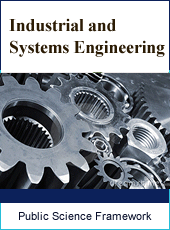Industrial and Systems Engineering
Articles Information
Industrial and Systems Engineering, Vol.1, No.1, Sep. 2016, Pub. Date: Jun. 29, 2016
Comparison of Aluminium Wheel to Steel Wheel in Relation to Weight and Fuel Consumption (Energy) in Automobiles
Pages: 1-9 Views: 3138 Downloads: 2327
[01]
Ikpe Aniekan Essienubong, Department of Mechanical Engineering, Faculty of Engineering, University of Benin, Benin City, Nigeria.
[02]
Owunna Ikechukwu, Department of Mechanical Engineering, Faculty of Engineering, University of Benin, Benin City, Nigeria.
[03]
P. O. Ebunilo, Department of Mechanical Engineering, Faculty of Engineering, University of Benin, Benin City, Nigeria.
The kinetic energy of a car is enabled by one of its most important components known as the wheel and depending on the weight and strength of the wheel, the car may require more or less torque to overcome the drag force acting in opposite direction of the car. In principle, a car with heavy body parts such as the wheel may have some limitation in terms of the speed, general performance, fuel consumption, CO2 emission etc compared to wheels produced from light weight materials. However, fuel consumption has remained a major concern to automobile industries in recent times, as this requires huge operational cost to enable auto users shuttle the required distance (kilometres). Consequently, CO2 which is a major Green House Gas (GHG) that results in global warming is generated at the detriment of public health and surrounding environment. This paper presents a cradle to gate life cycle assessment of two car wheel produced from aluminium alloy and high strength low alloy steel. CES software 2014 was used to conduct a full Eco-audit for cradle to gate life cycle of both auto wheels and the result was used to calculate energy consumption and CO2 emission at the USE phase of the aluminium and steel wheel in a distance of 180,000Km. From the energy breakeven point which occurred at a distance of 28,000Km with energy consumption of 850MJ (in terms of fuel consumption), aluminium alloy wheel consumed energy of 322MJ and 851MJ by steel wheel to cover a distance of 180,000Km. Also, from the CO2 breakeven point which occurred at a distance of 28,000Km with CO2 emission of 60Kg, aluminium alloy wheel constituted CO2 emission of 22Kg and 60.7Kg by steel wheel to cover a distance of 180,000Km. However, aluminium alloy wheel saved 529MJ of energy and 38.7Kg of CO2 to cover 180,000Km distance. Hence, it was concluded that aluminium alloy wheel is more economical in terms of fuel consumption and CO2 emission compared to steel wheel, though steel wheel has a higher strength than aluminium alloy wheel in real life applications
Automobile Wheel, Energy, Environment, Emission, Fuel Consumption, Global Warming, Weight
[01]
Allen, D. T. and Shonnard, D. R. (2012) Sustainable Engineeing: An Introduction to Sustainability. [online] available from <http://www.informit.com/articles/article.aspx?p=1828432> [20 December 2015].
[02]
Andy’s Auto shop (N.d) Wheel Weight. [online] available from < http://www.wheelweights.net/> [24 November 2014].
[03]
Bolten, W. (1998) Engineering Materials Technology. Butterworth-Heinmann-Linacre-Jordan Hill, Oxford OX28DP, 225 Wildwood Avenue, Woburn.
[04]
Chiaberge, M. (2011) New Trends and Developments in Automotive Industry. Intech, China. [online] available from <http://cdn.intechopen.com/pdfs-wm/13343.pdf> [23 November 2014].
[05]
Ezeonu, C., Tagbo, R., Anike, E. N., Oje, O., Onwurah, I. (2012) Biotechnological Tools for Environmental Sustainability: Prospect and Challenges for Environments in Nigeria, A Standard Review. International Journal of Biotechnological Research, Volume 2012.
[06]
Guler, D. (2006) Dynamic Analysis of Double Wishbone Suspension. Izmir Institute of Technology, Turkey. [online] available from <http://library.iyte.edu.tr/tezler/master/makinamuh/T000523.pdf> [20 November 2014].
[07]
Math Library (2013) Newton's Laws Applied to an Accelerating Car. [online available from <http://mathforum.org/library/drmath/view/67379.html> [20 November 2014].
[08]
Meghashyam, P., Girivardhan, S., and Sayed, N. (2013) Design and Analysis of Wheel Rim using CATIA & ANSYS. International Journal of Application or Innovation in Engineering and Management 2 (8), 2319 – 4847.
[09]
Prasad, B. and Kumar, M. (2013) Topology Optimisation of Alloy Wheel. Altair Technology Conference, India. [online] available from <http://altairatc.com/india/previous-events/2013/images/presentations/OS-15_TOPOLOGY_OPTIMIZATION-Hyundai.pdf> [29 October 2014].
[10]
Quadling, D. (2002) Advance Level Mathematics Mechanics 1. Published by Cambridge University Press. The Edinburgh building, Cambridge CB2 8RU, UK.
[11]
Schnubel, M. (2014) Today’s Technician: Automotive Suspension and Steering Class Room Manual and Shop Manual. Cengage Learning, p 607. ISBN: 9781305178410.
[12]
Stearns J., Srivatsan T., Gao, X., and Lam, P (2006) Understanding the Influence of Pressure and Radial Loads on Stress and Displacement Response of a Rotating Body: The Automobile Wheel. International Journal of Rotating Machinery 2006, 1-8.
[13]
Tester, T. W., Dreak, E. M., Driscoll, M. J., Golay, M. W., Peter, W. A. (2005) Sustainable Energy: Choosing Among Options. Publisher: PHI Learning Limited, New Delhi-110001.
[14]
Taiwan Turnkey (2014) Aluminum Alloy Wheel Making Plant. [online] available from <http://file:///F:/Second%20semester%20courses/Design%20and%20sustainbility/Taiwan%20Turnkey-Project%20Information%20%20-Aluminum%20Alloy%20Wheel%20Making%20Plant.html> [24 November 2014].
[15]
Wilson, W. and Sasseville, D. (1999) Sustaining environmental management success. New York: Wiley.
[16]
World Steel Association (2014) Sustainability. [online] available from <http://file:///F:/Second%20semester%20courses/Design%20and%20sustainbility/World%20Steel%20Association%20-%20Sustainability.html> [ 24 November 2014].

ISSN Print: Pending
ISSN Online: Pending
Current Issue:
Vol. 2, Issue 4, July Submit a Manuscript Join Editorial Board Join Reviewer Team
ISSN Online: Pending
Current Issue:
Vol. 2, Issue 4, July Submit a Manuscript Join Editorial Board Join Reviewer Team
| About This Journal |
| All Issues |
| Open Access |
| Indexing |
| Payment Information |
| Author Guidelines |
| Review Process |
| Publication Ethics |
| Editorial Board |
| Peer Reviewers |


